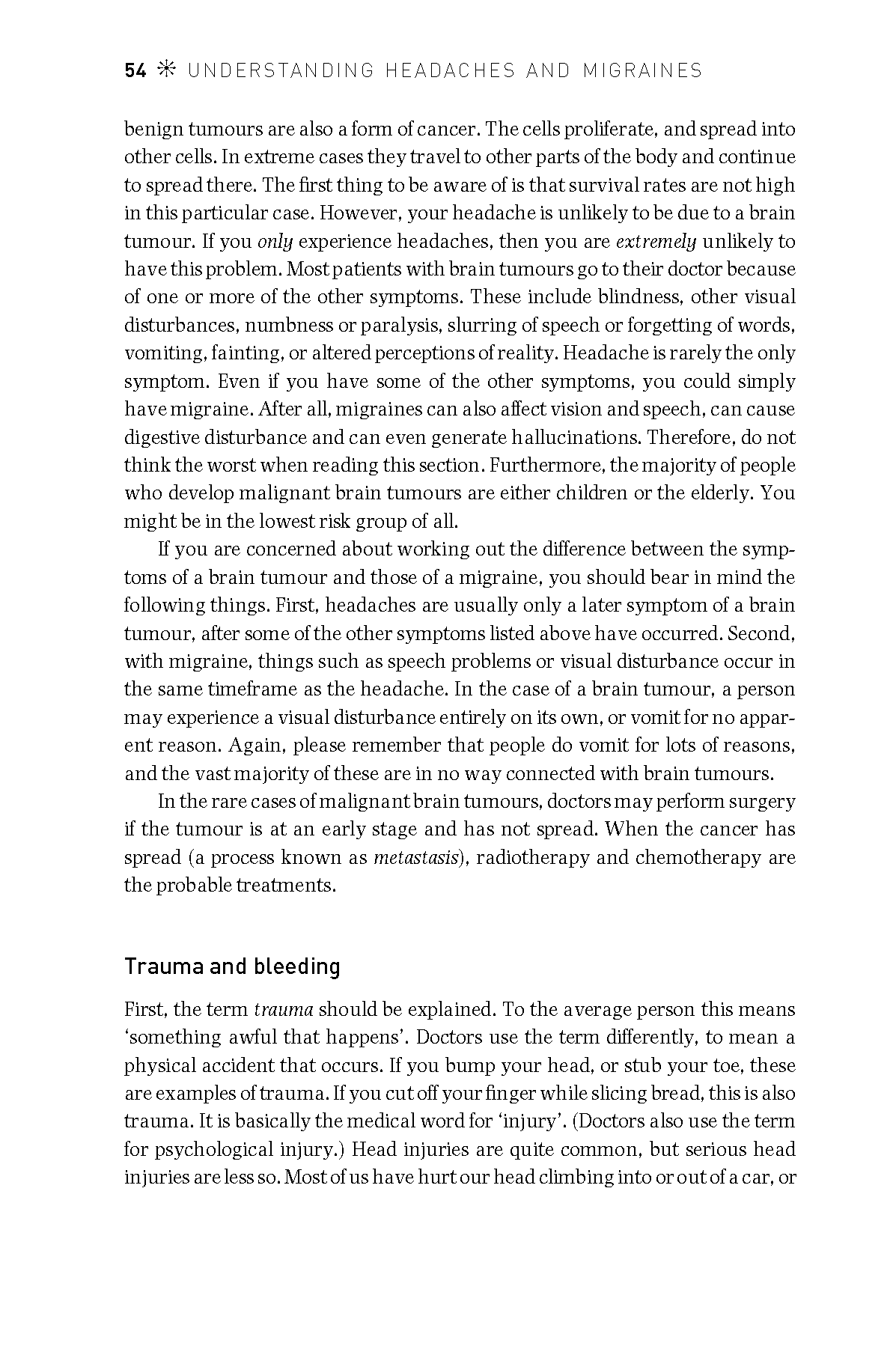UHAM071

54 ^ UNDERSTANDING HEADACHES AND M I G RAI N ES benign tumours are also a form of cancer. The cells proliferate, and spread into other cells. In extreme cases they travel to other parts of the body and continue to spread there. The first thing to be aware of is that survival rates are not high in this particular case. However, your headache is unlikely to be due to a brain tumour. If you only experience headaches, then you are extremely unlikely to havethis problem. Mostpatients with brain tumours go to their doctor because of one or morę of the other symptoms. These include blindness, other visual disturbances, numbness or paralysis, slurring of speech or forgetting of words, vomiting, fainting, or altered perceptions of reality. Headache is rarely the only symptom. Even if you have some of the other symptoms, you could simply have migraine. After all, migraines can also affect vision and speech, can cause digestive disturbance and can even generate hallucinations. Therefore, do not think the worst when reading this section. Furthermore, themajority of people who develop malign ant brain tumours are either children or the elderly. You might be in the lowest risk group of all.
If you are concerned about working out the difference between the symptoms of a brain tumour and those of a migraine, you should bear in mind the following things. First, headaches are usually only a later symptom of a brain tumour, after some of the other symptoms listed abo ve ha ve occurred. Second, with migraine, things such as speech problems or visual disturbance occur in the same timeframe as the headache. In the case of a brain tumour, a person may experience a visual disturbance entirely on its own, or vomit for no appar-ent reason. Again, please remember that people do vomit for lots of reasons, and the vast majority of these are in no way connected with brain tumours.
In the rare cases of malignant brain tumours, doctors may perform surgery if the tumour is at an early stage and has not spread. When the cancer has spread (a process known as metastasis), radiotherapy and chemotherapy are the probable treatments.
Traumaand bleeding
First, the term trauma should be explained. To the average person this means ‘something awful that happens’. Doctors use the term differently, to mean a physical accident that occurs. If you bump your head, or stub your toe, these are examples of trauma. If you cut off your hnger while slicing bread, this is also trauma. It is basically the medical word for ‘injury’. (Doctors also use the term for psychological injury.) Head injuries are ąuite common, but serious head injuries are less so. Most of us have hurt our head climbing into or out of a car, or
Wyszukiwarka
Podobne podstrony:
UHAM073 56 * UNDERSTANDING HEADACHES AND M IG RAI N ES she has ruled out all of the dangerous or lif
UHAM075 58 * UNDERSTANDING HEADACHES AND M IG RAI N ES actually take your mind off your headache whe
UHAM077 60 * UNDERSTANDING HEADACHES AND M IG RAI N ES troublesome. Most people who suffer from head
UHAM073 56 * UNDERSTANDING HEADACHES AND M IG RAI N ES she has ruled out all of the dangerous or lif
UHAM079 62 * UNDERSTANDING HEADACHES AND M IG RAI N ESPoints to notę • The consequ
UHAM019 2 ^ UNDERSTANDING HEADACHES AND M I G RAI N ES so it is with headaches. They differ in type
UHAM021 U UNDERSTANDING HEADACHES AND M I G RAI N ES can wake up still in pain. Generally, a migrain
UHAM029 12 ^ UNDERSTANDING HEADACHES AND M I G RAI N ES von Bingen. She died around 800 years ago an
UHAM031 H UNDERSTANDING HEADACHES AND M I G RAI N ES during pregnancy, especially if it is associate
UHAM035 18 * UNDERSTANDING HEADACHES AND M IG RAI N ES One particular problem in people in their lat
UHAM037 20 * UNDERSTANDING HEADACHES AND M IG RAI N ES episodes in Life and the onset of a headache.
UHAM039 22 * UNDERSTANDING HEADACHES AND M IG RAI N ES African-Caribbean people or Asian people (in
UHAM041 24 * UNDERSTANDING HEADACHES AND M IG RAI N ES is in intensity rather than quality. In all o
UHAM043 26 * UNDERSTANDING HEADACHES AND M IG RAI N ES A common migraine aura involves a scintiUati
UHAM045 28 * UNDERSTANDING HEADACHES AND M IG RAI N ES own migraine triggers, perhaps by maintaining
UHAM047 30 * UNDERSTANDING HEADACHES AND M IG RAI N ES it. Aft er a migraine attack, I can f ee L w
UHAM049 32 * UNDERSTANDING HEADACHES AND M IG RAI N ES get a full-blown attack. However, I do stillf
UHAM051 34 * UNDERSTANDING HEADACHES AND M IG RAI N ES can mean that I have to dnve everyone around
więcej podobnych podstron